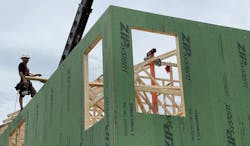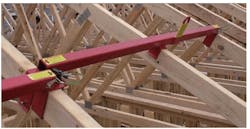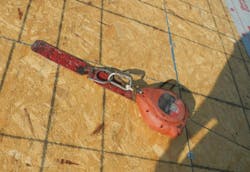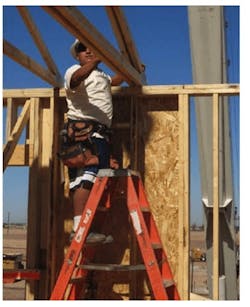Are you aware that a 200-pound worker wearing a safety harness and lifeline who free-falls 5 feet will generate 2,500 pounds of force on an anchor point?
I mention it because on jobsites I see plenty of lifelines fastened to anchor points held in place by just a few nails or screws. If a worker slips off the edge of a roof or wall, those nails or screws won’t keep them from falling all of the way to the ground, causing injury or even death.
Falls are the No. 1 cause of injury and death on construction jobsites.
Weak or inadequate anchor points are really just a symptom of a more basic problem: a complacent approach among contractors to preventing falls, even though falls are the No. 1 cause of injury and death on construction jobsites.
Maybe those contractors and builders don’t want to be heavy-handed with their crews, or maybe they view jobsite safety as one more to-do item on an already lengthy checklist. In fact, it’s not difficult to implement fall protection safety if you start with a few simple solutions—ones that workers are apt to follow. Consider these tips for quick, effective improvements to ensure jobsite safety.
RELATED
- Safe Scaffolding: Follow These Best Practices for Correct Setup
- NAHB Chairman's Message: Mental Health and Worker Well-Being
- Lower Workers' Compensation Costs by Having a Plan
Quick and Easy Improvements for Jobsite Safety
Harness and Anchor Point Safety Best Practices
Most discussions about harness systems focus on the part attached to the human, but the other end is equally crucial.
I recently saw an inadequately secured anchor point “holding” two framers on a second-story wall plate above a concrete stem wall. Had one of the workers fallen and landed on that concrete, chances are he would have been killed or crippled.
The safety fix would simply have been to drive sinkers through every one of the 15 holes in the anchor’s strap, not just the one nail used. I’ve also seen workers nail through a thick-gauge nylon rope they’re using for fall protection.
The bottom line? Do not trust lives to jerry-rigged, site-made solutions. Invest in actual anchor points and use them as intended, every time on every job.
Fall Protection: Scaffolding
Of course, harnesses with anchor points aren’t always the best solution for fall protection.
For instance, when first setting floor or roof trusses on framed walls, there is no elevated point at which to tie off a harness. A foot-level anchor won’t protect a worker on a first-story wall plate because the worker will slam into the ground long before the safety line goes taut. In those instances, you need scaffolding.
Reusable interior or exterior bracket scaffolding is the best solution, and more builders are requiring framers to use it. But what if neither the builder nor the framer wants to purchase the scaffolding?
RELATED
Another Good Option for Jobsite Safety: Ladders
In that case, working from a ladder when setting trusses is a good alternative, and it’s certainly safer than walking the top plate without any lifeline.
OSHA requires fall protection at any height 6 feet or more above the ground or deck. If you’re setting trusses on an 8- or 10-foot-high one-story framed wall or foundation wall, a ladder will keep a worker’s feet below that 6-foot threshold.
Crews also won’t have to take the time to set up and break down scaffolding; the only expense may be a couple of extra ladders. Of course, the ladder approach works best if there’s a crane lifting the trusses into place, relieving workers from awkward (read: dangerous) materials-handling chores.
No one wants injuries on the jobsite, but hope is not a strategy. At the same time, complying with safety measures can be difficult. A good start to a safer jobsite is to work with your framing and roofing subcontractors to implement these simple approaches.
John Koenig drives quality and performance in home building as a building performance specialist on the PERFORM Builder Solutions team at IBACOS.




